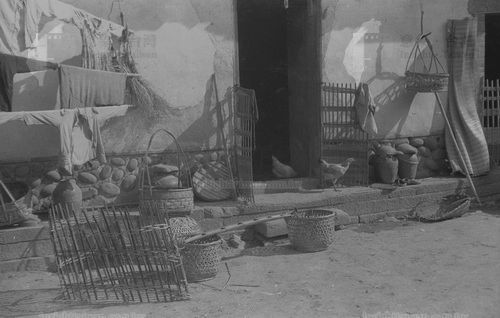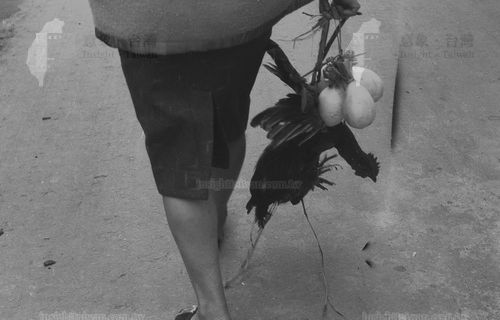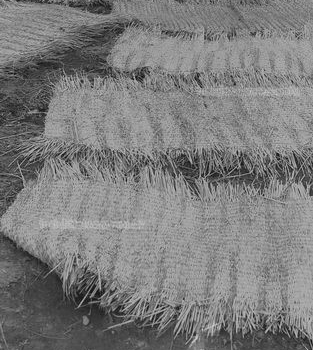In the early agricultural society, many household appliances were made by farmers themselves using the surrounding plants. Among them, salty grass is widely used, such as straw rope, straw mat, straw hat and straw shoes are very popular! The Fuzhou area of Shezi Island used to had a history of salty grass industry. According to Mr. Jitong, a local elderly man, salty grass was naturally grew on the river side many years ago. Because of its economic value, farmers began to plant a large amount and sold it to the urban area such as Dadaojing and Mengjia.

Countryside yard (The straw mat is on the far right)
The salty grass of Shezi Island is also called sedge grass. In the early days, the river banks of Luzhou and Shezi Island were mainly bred with reeds and sage grasses. Large sedge grasses swayed in the wind in the sunset. The growth of salty grass in the Shezi Island area can also be seen from the history books. In Chen Peigui's (1871) "Tamsui Hall: The Map of Danshui Hall" mentioned "salty (salty) Caopu", in fact it is Refers to the Shezi Island area today. The salty grass has dense spikelets, triangular stems, thick and flexible rhizomes, and can reach more than 1 meter in length. In early Taiwanese farmers, it dried their stalks as hand-woven straw ropes, The material of straw mats was one of the sources of income for farmers on the banks of the Keelung in the era when the plastic industry was not yet developed.

salty grass (short-leaved Malacca galingale)
Another old Mr. Lin Qingzhang recalled that about 50 to 60 households in Dingfuzhou had planted salty grass as their main economic source, and most of them were self-sold. The salty water required for salty grass must be moderate in order to grow high-quality salty grass, and the straw mat processed will be comfortable to sleep. Salt grass can grow up to seven feet long, and it was planted both inside and outside the embankment. After harvesting the salty grass, it must be cut in half first and then exposed to the sun for three days before it can be made into a straw mat. It takes about 3 to 4 days for the two to work together to weave a straw mat. The salty grass can be harvested twice a year. The first phase of harvesting is from April to May, when the salty grass has not yet bloomed. The second phase of harvesting is from August to September. The rope will also be stronger. The output of the entire Fuzhou area is about 300 kilograms, which is mainly sold in the Greater Taipei area. However, if you encounter dumplings during the Dragon Boat Festival, there will be a shortage of supply and you will have to purchase from the south. In 1979 (1979), the plastic industry began to flourish, and the sage grass was slowly replaced by it. With the decline of the industry, farmers no longer planted. In addition, in recent years, the water quality has become salty.

Celery rope
straw mat
Reference source:
A.PAO garden
Taiwan River Rehabilitation Website
Taiwan e-Learning & Digital Archives Program. "Business photo gallery and amateur works during the Japanese rule." [Online] https://catalog.digitalarchives.tw/Organization/List.jsp?CID=58636
- Q1. What are the differences / identities between before and now? A: In the past, handicrafts were diversified, not only in daily necessities, but also in food. In the past, people often pushed carts to sell their own handmade ice cream, and some people called to sell handmade rice dates. They were all from Shezi Island Precious assets, as time goes faster and faster, people will always seek freshness and integrate more external information, but time passes quickly. If no one is willing to learn traditional culture, but constantly pursue fashion, they will only Can become memories.
- Q2. Is there anything you think is good or bad? A: People always like the new and hate the old, and will pursue new things. This mentality can make Shezi Island more diverse, but it does not mean that the previous "precious assets" should be completely abandoned. While progressing, it should also retain culture and create Better new "cultural assets". In the past, a kind of plant called "salted grass" was planted. It was the main economic source at that time. The harvested salty grass can be made into straw mats. It takes 3-4 days for the two to work together. With the prosperity of the plastics industry, the salty grass was slowly replaced, and the water quality was gradually salinized, and the salty grass began to disappear in Shezi Island.



